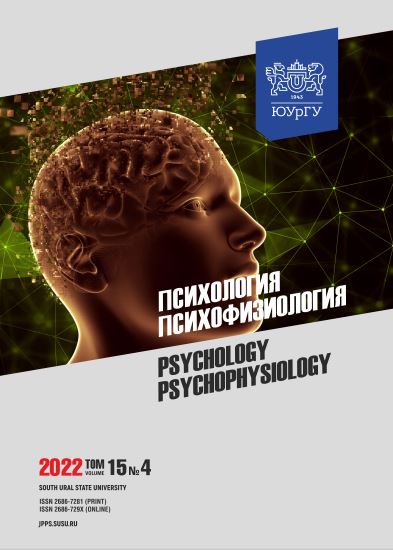Correction of emotional disorders as a means of preventing violence and cruelty of adolescents
Abstract
The article describes the conditions and methods, techniques of correction of emotional disorders of adolescents that cause violence and cruelty in the adolescent environment, in the context of personality-oriented education that affects self-actualization and socialization of the individual. The presented recommendations for correction of emotional disorders and deviant behavior of adolescents can be useful to parents, psychologists, teachers and other professionals in the process of working with this category of persons. Aims: to identify the specifics of methods and means of correction of emotional disorders as a means of preventing violence and cruelty of adolescents. Materials and methods. Theoretical analysis of literary sources for the study and generalization of available research on the problem of correction of emotional disorders as a means of preventing violence and cruelty of adolescents. Results. Techniques, tools and recommendations for conducting psychocorrective work with adolescents with emotional and personal disorders are proposed. Conclusion. Based on the analysis of scientists' research, some guidelines have been made in terms of determining ways and methods of correctional work with adolescents, taking into account their individual life activities, individual problems and characteristics of character and behavior.
Downloads
References
2. Vrono E. Life is a penny. Zdorove shkolnika = School student health. 2012;2:60–61. (in Russ.).
3. Gilinsky Ya.I. Deviantology: sociology of crime, drug addiction, prostitution, suicide and other “deviations”. St. Petersburg: Publ. house “Alef-Press”, 2013:650. (in Russ.).
4. Shalomova E.V. Moral education as an important condition for the prevention of addictive behavior of adolescents. Mir nauki, kultury, obrazovaniya = The world of science, culture and education. 2018;3(70):154–158. (in Russ.).
5. Prutchenkov A.S., Snylov A.A. Ei ty, paranoik! O psikhotipakh lichnosti, o diagnostike aktsentuatsii kharaktera detei i pedagogicheskoi pomoshchi im [Hey you, paranoid! About personality psychotypes, about the diagnosis of accentuation of the character of children, and pedagogical assistance to them]. Moscow: Novaya shkola Publ. 1994:64. (in Russ.).
6. King P. Assertiveness: speak out. To say “o”. Set boundaries. Get control. Pkcs Media, Inc. 2019:262.
7. Trusova A.S., Korepanova E.A. Assertiveness as a method of protection from psychological destructive influence (on the problem of psychological security of the educational environment). Nauka i obrazovanie = Science and Education. 2018;3-4. URL: http://opusmgau.ru/index.php/see/article/view/532
8. Galstyan G.S. The influence of alcohol and drug addiction on juvenile suicide. Vestnik Adygeiskogo gosudarstvennogo universiteta. Regionovedenie: filosofiya, istoriya, sotsiologiya, yurisprudentsiya, politologiya, kulturologiya = Bulletin of the Adygea State University. Series "Regional Studies: Philosophy, history, sociology, law, Political Science, cultural Studies. 2010;3(64):158–162. (in Russ.).
References on translit
1. Vasilchenko M.V., Dautov D.F. Some features of suicidal behavior of teenagers. Izvestiya Yuzhnogo federalnogo universiteta. Pedagogicheskie nauki = Bulletin of the Southern Federal University. Pedagogical sciences. 2015;6:149–1542. Vrono E. Life is a penny. Zdorove shkolnika = School student health. 2012;2:60–61. (in Russ.).
3. Gilinsky Ya.I. Deviantology: sociology of crime, drug addiction, prostitution, suicide and other “deviations”. St. Petersburg: Publ. house “Alef-Press”, 2013:650. (in Russ.).
4. Shalomova E.V. Moral education as an important condition for the prevention of addictive behavior of adolescents. Mir nauki, kultury, obrazovaniya = The world of science, culture and education. 2018;3(70):154–158. (in Russ.).
5. Prutchenkov A.S., Snylov A.A. Ei ty, paranoik! O psikhotipakh lichnosti, o diagnostike aktsentuatsii kharaktera detei i pedagogicheskoi pomoshchi im [Hey you, paranoid! About personality psychotypes, about the diagnosis of accentuation of the character of children, and pedagogical assistance to them]. Moscow: Novaya shkola Publ. 1994:64. (in Russ.).
6. King P. Assertiveness: speak out. To say “o”. Set boundaries. Get control. Pkcs Media, Inc. 2019:262.
7. Trusova A.S., Korepanova E.A. Assertiveness as a method of protection from psychological destructive influence (on the problem of psychological security of the educational environment). Nauka i obrazovanie = Science and Education. 2018;3-4. URL: http://opusmgau.ru/index.php/see/article/view/532
8. Galstyan G.S. The influence of alcohol and drug addiction on juvenile suicide. Vestnik Adygeiskogo gosudarstvennogo universiteta. Regionovedenie: filosofiya, istoriya, sotsiologiya, yurisprudentsiya, politologiya, kulturologiya = Bulletin of the Adygea State University. Series "Regional Studies: Philosophy, history, sociology, law, Political Science, cultural Studies. 2010;3(64):158–162. (in Russ.).
Copyright (c) 2022 Psychology. Psychophysiology

This work is licensed under a Creative Commons Attribution-NonCommercial-NoDerivatives 4.0 International License.



